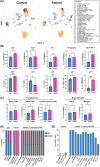Long-term assessment of haematological recovery following somatic genetic rescue in a MYSM1-deficient patient: Implications for in vivo gene therapy
- PMID: 39233474
- PMCID: PMC11637720
- DOI: 10.1111/bjh.19744
Long-term assessment of haematological recovery following somatic genetic rescue in a MYSM1-deficient patient: Implications for in vivo gene therapy
Abstract
MYSM1 deficiency causes inherited bone marrow failure syndrome (IBMFS). We have previously identified an IBMFS patient with a homozygous pathogenic variant in MYSM1 who recovered from cytopenia due to spontaneous correction of one MYSM1 variant in the haematopoietic compartment, an event called somatic genetic rescue (SGR). The study of the genetic and biological aspects of the patient's haematopoietic/lymphopoietic system over a decade after SGR shows that one genetically corrected haematopoietic stem cell (HSC) can restore a healthy and stable haematopoietic system. This supports in vivo gene correction of HSCs as a promising treatment for IBMFS, including MYSM1 deficiency.
Keywords: MYSM1; bone marrow failure; haematopoiesis; natural gene therapy; somatic genetic rescue.
© 2024 The Author(s). British Journal of Haematology published by British Society for Haematology and John Wiley & Sons Ltd.
Conflict of interest statement
The authors declare no conflict of interest.
Figures


References
-
- Revy P, Kannengiesser C, Fischer A. Somatic genetic rescue in Mendelian haematopoietic diseases. Nat Rev Genet. 2019;20:582–598. - PubMed
-
- Le Guen T, Touzot F, Andre‐Schmutz I, Lagresle‐Peyrou C, France B, Kermasson L, et al. An in vivo genetic reversion highlights the crucial role of Myb‐like, SWIRM, and MPN domains 1 (MYSM1) in human hematopoiesis and lymphocyte differentiation. J Allergy Clin Immunol. 2015;136:1619–1626. - PubMed
Publication types
MeSH terms
Grants and funding
LinkOut - more resources
Full Text Sources
Medical

